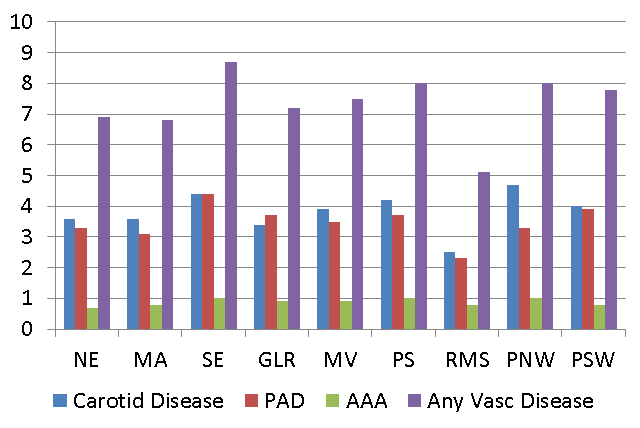Back to 2016 Annual Symposium Abstacts
Geographical variation in the prevalence of peripheral vascular diseases in the United States
Caron Rockman, MD, Glenn Jacobowitz, MD, Thomas Maldonado, MD, Mark Adelman, MD, Jeffrey Berger, MD.
New York University Medical Center, New York, NY, USA.
Objectives: Epidemiological studies of peripheral vascular diseases have focused mainly on traditional risk factors. Variations in the prevalence of vascular diseases in different geographical regions of the US have not been well studied. The objective of the current study was to analyze the variance in the prevalence of carotid artery stenosis, abdominal aortic aneurysm, and peripheral arterial disease in the different geographical regions of the United States.
Methods: The continental US was divided into nine geographical regions: Northeast (NE), Mid-Atlantic (MA), Southeast (SE), Great Lakes Region (GLR), Mississippi Valley (MV), Plains States (PS), Rocky Mountain States (RMS), Pacific Northwest (PNW), and Pacific Southwest (PSW). Subjects who underwent voluntary vascular screening examinations were utilized. PAD was defined as an ABI ≤ 0.9; carotid artery as stenosis ≥ 50%; and AAA with aortic diameter ≥ 3 cm. At least 140,000 subjects from each geographical region were analyzed.
Results: 3,695,555 subjects were analyzed. The prevalence of PAD varied from 2.3% in the RMS to 4.4% in the SE. The prevalence of carotid stenosis varied from 2.5% in the RMS to 4.7% in the PNW. There was less overall variation in the prevalence of AAA by geographical region. When considering the presence of disease in any peripheral vascular territory, the prevalence ranged from 5.1% in the RMS to 8.7% in the SE. Multivariate analysis controlling for traditional risk factors confirmed that subjects from certain geographic regions have an increased or decreased risk of vascular diseases when compared to the Northeast. For example, the MA region had an increased risk of any peripheral vascular disease (OR 1.3), while the PS region had an overall decreased risk (OR 0.77).
Conclusions: There is significant geographic variance in the prevalence of vascular diseases in the United States, which remains even when controlling for traditional atherosclerotic risk factors. It is unclear whether these differences may be related to genetic, lifestyle or dietary factors. Nevertheless, this novel information may suggest possible environmental etiologies of vascular diseases, and can be used to improve screening, prevention and treatment strategies, as well as vascular surgery manpower issues concentrated in certain geographical areas.

Back to 2016 Annual Symposium Abstacts
|







